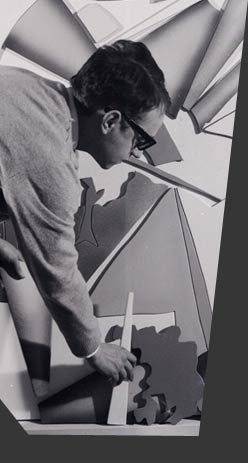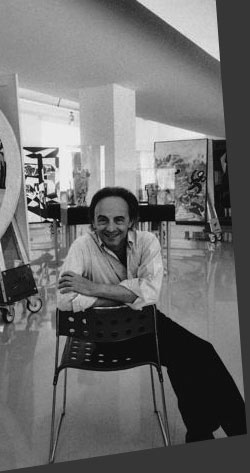Luca Beatrice
UGO NESPOLO 1967-1968. A START
There is a big difference between artists who formed in the sixties and those who did later, in the following decade. This discrepancy is immediately evident not only for the works but mainly for theoretical reasons that the authors used to superimpose to the artefacts. At the time ethics were connected to aesthetics and any gesture had its own cultural and existential necessity. So, nothing for free. In the first post war "golden age" of Italian culture each work found a reason in the perceptive observation of the social, in the meantime developing in different degrees. Those who dwelled on political and ideological issues and those who tried to overcome this challenging obstacle choosing other ways at the risk to appear out of context, and maybe heretical.
The case of Ugo Nespolo belongs to this (a more rare) family of artists that leave behind the season of hardness and contrast. His view of the world on his precarious balance and the sparks ready to start a fire in factories, schools and squares is immediate and urgent. Also is his taking the distance from ideology through a linguistic-expressive instrument, not very popular at the time: irony and lightness. Born in 1941, Nespolo begins in Turin in 1966 at the Gallery Il Punto of Remo Pastori, talent scout and outsider (on who abound amusing and paradoxical anecdotes. His apprenticeship lasts only a few months, because in 1967 his trials appear mature as well as intriguing: Here begins the backward look, not retrospective, which allows us to investigate on the initial insights of Nespolo that contribute to form fundamental traces of Italian art for future generations, not only within the authors personal poetic.
Irony and lightness, we said. Talking about it on the eve of the strongest social and political revolution of the sixties, 1968 was considered a crime just as much as to mention the ornament for the theoretical Bauhaus Adolf Loos. In fact, its enough to consider his practically total absence from the Arte Povera Movement, who's adventure begins right in 1967, pivotal year for Italian art and beyond, that had Nespolo among its supporters and thoughtful receptors, but not among the official members. Because the rebel runs alone, and that is what the artist is in his best intentions.
The determinant exhibition in order to understand the mood of this predicament, is held in Turin, and is a flash project with interesting ideas that we call "rational". Con temp l'azione is the enigmatic title of the example of the habits in vogue in the sixties to break up words with or without a hyphen, played at the same time in three galleries under the Mole: Il Punto that represents Nespolo, Christian Stein, the future space of Arte Povera and Gianenzo Sperone, close to the "big American adventure". Eleven are the artists involved, like in a soccer team, which form two complementary but different ones. The first with Aldo Mondino, Ugo Nespolo, Giulio Paolini, Gianni Emilio Simonetti, Gianni Piacentino, Getulio Alviani e Paolo Scheggi, or rather the non-aligned, the most difficult to define, who arrive to the conceptual experience by Pop Art, visual poetry or kinetic art. The second formed by Michelangelo Pistoletto, Luciano Fabro, Gilberto Zorio, Giovanni Anselmo, organic from the first moment to Arte Povera. In between is Alighiero Boetti appointed in the lucky group, but up to his death (in Rome 1994) was the heretic and diverse soul, although becoming a record man with his quotations on the international art market.
In any case during the sixties its out of question that to earn the right to citizenship in the emerging system the artist has to operate within the canons of the vanguard, that has precise limits and a well defined generality. Ugo Nespolo takes the concept in a historical-modernist way. Following the Futurists and the Marinetti dictates he shows that the vanguard is first of all a state of mind and a pattern of behaviour and then a production of objects. From vintage photos we find a twenty-six year
old dandy, transformer, ironic disturber and slight provocateur. He remains between things without belonging to any of them, goes through them and buries them with a laugh.
Ugo Nespolo is one of those rare artists that act as a "zipper" between an old and a new world or rather simply between modern and post-modern Until then art was placed into a mechanism of Darwinian evolution (a new vanguard is placed at the peak of a process with the target to overcome it) , from then on he begins to consider history not as an enemy but as a reservoir of images to remix and contaminate with others. First art is absolute and the relative. First it is limited to a few and selected languages, then it incorporates various and unexpected ones. Like a mass production and design. First its gesture then it becomes machine. First its category of the spirit then high and low at the same time. (I'll open a significant parenthesis. Several years later in 1990, the MoMa in New York presents the epochal exhibition entitled High & Low organized by Kirk Varnedoe, a testament to his receptivity to things in the moment of their making.
Several interesting works of the "first" Nespolo are dated 1967. Before he discovered his linguisticsymbolic figure, that will make him unique starting from the beginning of the following decade, leaves, spreads around, tracks and attempts of art work with the experimental anxiety typical of a young man in the middle of an educational novel. Seduced by the literature as well as by the visual vanguard, Nespolo is an artist "à la Pérec" as meaning that just like the great French artist he prefers the classification and enumeration instead of an expressive connotation. As well as his friend Boetti, but Nespolo eagerly feels the limit of the two and three dimensional and already sees himself in alternative, launched towards experimental cinema of non-fiction that in Turin, particularly, has several followers (Tonino De Bernardi, Plinio Martelli, Paolo Menzio, Pia Epremian).
Back to plastic art, decisive for Nespolo is the discovery of the puzzle: interlocking, creation and recreation, disassemble and reassemble, the work is never definitive (exact opposite of the monumental Arte Povera that produces gigantic installations to invade and restate the space), but precarious, uncertain, unstable. Sometimes squeezed with clamps so they won't run away, the materials are infinite, reassembled and valid. The ephemeral lightness is the theoretical basis for a new artist, postmodern like the overlooking era, at least in America.
Nespolo's minimum gesture, anti-heroic, surprisingly ahead of all times, is far away even from Land Art or from the priestly guru attitude of ritualistic gesture that many put in their recitatives (as in the review Arte Povera + azione povera in Amalfi in October 1968 with the one for all participation of Jan Dibbets that places a white line of 25 cm. below the sea level. It's a consequence, the introduction of a parodistic element: in 1969 in San Benedetto del Tronto (a little town on the Adriatic sea, place where Nespolo will always be linked to and where he installed the most beautiful of his public sculptures "Lavorare lavorare preferisco il rumore del mare" quote of a verse from the poet Dino Campana) performs a real environmental intervention using a machine for road signs, but instead of lines, concepts or abstractions, he draws on the asphalt in a central area, a large childish sun. Seems like the first of a series of grimaces, however affectionate, for his serious colleagues (see Dennis Oppenheim). Another one who ended under attack by this disciple of Duchamp is Joseph Beuys, artist that more than others, epitomizes the theoretical and ideological rigor towards the beginning of the seventies, starting from the hat sign of wisdom and with an explorer look. Ugo dresses up like a new Marcel and will affix his scribbles to the portrait of the preacher Kretzfeld, for a tease and a little gesture of love, photographed ridding a "powerful" VeloSolex, forerunner of the Ciao Piaggio. Generally, Nespolo's performances (this term does not suit him, as he does not act like a possessed in front of a cheering audience) stand on useless gestures and with no special meanings, such as carrying a mattress where the chance of failure is high. Essential goal at the time (I would mention the seminal intuitions of Bas Jan Ader), will be the foundation of the art of the nineties after the collapse of the twentieth century ideologies. If we want to find connections with behavioural art, what moves Nespolo is not the action but "doing nothing" so dear to Oblomov, a Goncarov character taken
up by Maurizio Cattelan and to the beloved Campana: very subversive idea of art because it has no added value. An anti- glorious where you just know that it happened but its not necessary to have attended the vacuous and improvised rite that rapidly turns into a ritual.
Its not by a chance that the first gallery of reference throughout the country is the one of Arturo Schwarz, the forge and the cuisine of ideas that the volcanic critic, historian of Judaism opened in Via del Gesù 17 in Milan. Nespolo starts to work with him in 1968, in a quite different situation than the one in Turin, always ready to set up groups and precise trends. Schwarz's idea, who always looked at art in a unorthodox and freeway, coincides with the anti-movement where the irrational is exposed to the organization and his creative madness starts right from the invitations of the exhibitions, intriguing shots and photographic assemblies catching ideas from Surrealism, Pop Art and lower cultures. The names of the gallery artists written on lollipops, on a wall with obscene writings and political outbursts, on a box of Minerva matches (historian matches of the Monopoly), leaves no doubt on the poetic versatility of the gallery owner ranging from vanguard (Duchmp, Picabia, Schwitters) to Pop (Adami), from Nouveau Realisme (Arman) to Fluxus (Brecht) from a great isolated sculptor as Alik Cavaliere to the last generation (Baruchello and Nespolo ).
In May 1968 Ugo Nespolo goes back to the Gallery Il Punto with a risky operation, considering the difficult historical and political period, context in which it did not take much to add fuel on fire. Its entitled Molotov, three works for a non-generic exhibition, but its not a declaration to a political belonging or a sympathy like Mario Schifano was doing in Rome with his paintings Compagni, compagni. Everything starts with a little drawing made with a typewriter, that introduces the installation vaguely poor nature, a trapeze open at the sides with broken glass bottles stuck inside with a burning fuse. The perfect art work that represents the atmosphere at that time, which Francesco Bonami published in Italics, a complete review from 1968 to the present. (Palazzo Grassi, Venice 2008). Of course we could be tempted to read the provocation by Ugo based on the experience at that time, yet Molotov brings to mind a historical retribution, from the years of the economic boom, symbolized by Olivetti letter 32, one of the most important objects of Italian design produced in the sixties, to the first serious crisis since the post-war period until now and to the social disorders that were spreading. About Nespolo's sharp foresee, at the end of the â80's the artist from Milan, Massimo Kaufmann will repeatedly draw with the typewriter (portraits of writers and the entire cycle of Goya's Caprichos) and installation of cars, brings to mind a possible single version of "duchampian" memory: and the, Nespolo's glance on Italy towards the end of the sixties, the source of the photographs, that rarely lie appears at least puzzled, sign that doubts are stronger than sureness.
Chased by experimental anxiety involving all possible languages, without excluding any, between 1968 and 1969 Ugo Nespolo returns to cinema, after his debut in 1966 with "La galante avventura del cavaliere dal lieto volto" (in which recites Lucio Fontana). The inspiration for his films often starts with the portraits of his friends and colleagues, like Neomerzare (1967), A.G. (with protagonist Allen Ginsberg, 1968), Boettinbianchenero (1968), Buongiorno Michelangelo (referring to Michelangelo Pistoletto 1968). At the same time he dedicates himself to the art of drawing, that helps him keep his manual ability and expressive fantasy, using it tangential to the contemporary experience of Baruchello, above all preview of the post-modern taste for the mechanism of combination/recombination/quote, many years before its widespread distribution in Italy.
We cannot be miss in analysis of these years, the relationship with Fluxus "organized" team beyond the most anarchist and libertarian in the sixties, therefore closer to Nespolo's nature. In April 26, 1967 he "performs" with Ben Vautier and Gianni Emilio Simonetti at the City Gallery of Modern Art in Turin (that today is called GAM) for the opening of the Museum of Contemporary Art. We can see him in photos while he carries around writings of Ben that say, "Art is useless", then tied up with the other two, but what is striking is the "nespoliano" look, Ray Ban Wayfarer, black leather jacket.
Quotes by Andy Warhol in an industrial metropolitan version in Turin, city of automobiles. A subsequent Fluxus exhibition at the Punto entitled "Le mots et les choses" as Michel Foucault's essay in 1966, and its generally the French culture in the context of OuLiPo (even in the wake of the presence of Italo Calvino in Einaudi) with the deconstruction of the language that attracts Nespolo, who studies and "translates" in plastic-behavioral trials the writings of Pérec and Queneau (a side note: the invitation of the performance Fluxus staged at the Bertesca Gallery in Genoa, is published with an irreverent cartoon on the back of a petomane, literally taken from a publication of trivial humour, a similar action used by Richard Prince in the â80's).
During the fervid activity between 1967-1968 Ugo Nespolo is not only one of the most creative and restless artists on the Italian scene; reading about his work in retrospective, its evident that he has guessed (and unknowingly anticipated) that micro neo-conceptual (affirmed especially in Milan) in the second half of the â80's at the end of the pictorial experience of Transavangarde et consimilia. Nespolo's irreverent nature makes us doubt on the need of a language and a style convincing all that everything can be said in a different way with the right tools. Adopts mainly precarious materials for anti-monumental objects in which repetition is never serial but single act. In the sculptures of twisted wicker he anticipates of thirty years Giuseppe Gabellone; chooses the rhetorical of natural colour (in the â90's absolutely dominant in Antonio Catelani and Berhard Rudiger) both wood, cardboard, packing or custody in the absolute brilliant intuition (shared in part with Giulio Paolini, so the back of the canvas becomes at last, painting), that we are heading towards a time where who dominates is not the expertise but the museum the only responsible for certifying an art work that will provide an opportunity for a Pop iconographic reflection of Nespolo during the â70's.
Compared to the gigantism of Arte Povera Nespolo neglects the spaces and puts his effort on the objects, taking the risk of trespassing into design. Mocking and sarcastic, he seems to say that it does not take a special talent to become an artist and not even a physical effort. In a short period of time he produces a large amount of art work that together is amazingly countercurrent.
The next revolution is by chance, on a smaller scale, in "Piccoli legni" (1968), an installation consisting in five small wooden interlocking objects with a light aniline painting. It's the work that gives the rise to Nespolo's second half.
(From the book: Nespolo, The years of the Avantgarde, Surprise, Galleria d'Arte Moderna, GAM, Torino, 2013, FMR-ARTE', Bologna)



